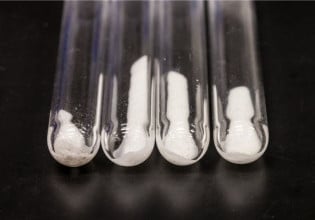Fraunhofer Develops Self-cleaning Surface Coating for Solar Tech
Researchers have developed a self-cleaning titanium dioxide-based coating for keeping solar installations and glass facades dirt-free.
Under the NewSkin project, the Fraunhofer Institute for Organic Electronics, Electron Beam and Plasma Technology (Fraunhofer FEP) has developed the first coatings of super-thin glass with crystalline titanium oxide using a roll-to-roll system. The titanium-dioxide-based coating could help keep solar installations and glass facades free of dirt, improving energy production and the availability of natural light in indoor spaces. Fraunhofer FEP will present initial results at the April BAU 2023 trade fair in Munich.

In its hydrophobic state, Fraunhofer FEP’s titanium dioxide surface coating repels water, which causes water droplets to form. Image used courtesy of Pixabay
A Self-cleaning Coating
How do these self-cleaning coatings work? Fraunhofer FEP researchers focused on a compound known as titanium dioxide, which changes its hydrophilicity when exposed to ultraviolet (UV) radiation.
Hydrophilicity is a material or surface property that attracts water molecules. When titanium dioxide is not exposed to UV light, it is hydrophobic or water-repellent, forming water droplets. When exposed to UV radiation, titanium dioxide becomes superhydrophilic, which means it has a high affinity for water.
Hydrophilic substances have high surface tension, allowing them to form strong bonds with water molecules and other polar substances. This is an attractive property for the production of medical implants, coatings for consumer products, or renewable energy technologies.

Fraunhofer FEP’s self-cleaning titanium dioxide-based coating is designed to help keep surfaces dirt-free without needing costly manual labor. Image used courtesy of Pixabay
According to Fraunhofer FEP, surfaces with a titanium dioxide surface coating change from hydrophobic to superhydrophilic in about 30 minutes when irradiated with sun-like UV light.
Dirt, dust, and other particulates that might settle on solar panels or glass facades with Fraunhofer FEP’s titanium-oxide glass coating will wash off during the night in its hydrophobic state. As the coating changes between its hydrophobic and superhydrophilic state during the day, the dirt and other particulates wash away and cannot stay settled on its surface.
Coating Development and Challenges
The Fraunhofer FEP researchers applied 30 to 150 nanometers of titanium oxide to a 20-meter-long roll of thin glass using a roll-to-roll process. The glass was 30 centimeters wide and had a thickness of 100 micrometers. Although glass is suitable for the roll-to-roll process, it is difficult to handle without breaking and is sensitive to mechanical and thermal stress.
The roll-to-roll manufacturing process involves continuously unrolling flexible substrates (such as plastic film, metal strips, metal foil, or ultra-thin glass) onto an assembly line. The process also involves the deposition or modification of materials on these substrates.
Before using glass, substrates such as films could not handle the high temperatures required in the roll-to-roll system to produce crystalline titanium dioxide.
NewSkin Open Innovation Test Bed
The European Union Horizon 2020 program supports the NewSkin project under grant agreement No. 862100. The NewSkin Open Innovation Test Bed provides innovators (like Fraunhofer FEP) with the facilities and equipment to further develop and industrialize advanced nanotechnology-based surface technologies.
Companies and institutions working alongside NewSkin have access to ten upscaling facilities, pilot scale prototyping, nine testing facilities, and other services that help speed up the transition from bench-top research to technology commercialization.
Fraunhofer FEP will further its research efforts, developing layer systems activated by visible light, and is already considering the production and integration of nanoparticles. Additionally, the Fraunhofer FEP researchers will continue to grow and fine-tune the newly developed coatings to reduce costs and improve performance under the NewSkin project. Technologies within the NewSkin test bed will target different areas of industry, including transport, construction, optics and electronics, and renewable energy.






